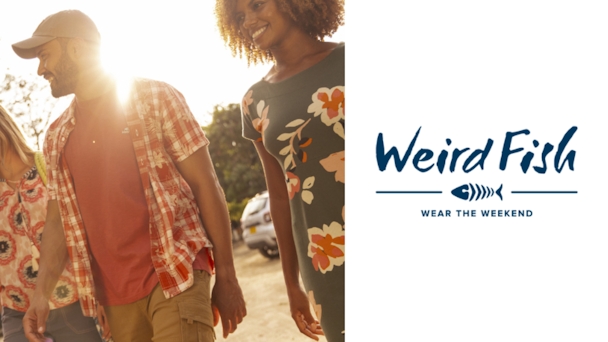How Weird Fish ditched discounts, refreshed its image and won over younger consumers
Winning the Gold award at The Drum Awards for Media 2024 in the Performance category is Launch for Weird Fish, with a robust performance strategy that helped bolster brand reputation and drive sales. Here is the award-winning case study.

Weird Fish renewed its image while attracting younger customers with a refreshed performance strategy / Weird Fish
Planning and objectives
Keen to ditch an over-reliance on discounting in favor of stronger brand-led campaigns, UK-based clothing retailer Weird Fish partnered with Launch on a multichannel performance strategy to drive website sales, elevate brand reputation and wean customers off discounts to improve margins.
This was, of course, no easy task during a cost of living crisis, with bargain prices a top consumer priority. The challenge was compounded by crowded e-commerce market conditions in which increasing numbers of online fashion retailers are competing for consumers' limited disposable income.
In particular, the brand hoped to achieve a 30% increase in the clickthrough rate on non-sales-focused ads across paid search and paid social. As part of its objective to boost brand awareness, Weird Fish also wanted to lift impressions for specific Google Search keywords by 15% year-over-year (YoY) and grow average order value for Google and Bing ads by 6%. On Meta, the brand aimed to increase average order value via ads by 15% while also boosting YoY return on ad spend on Meta by 7%.
Want to go deeper? Ask The Drum
Strategy
A crucial element of this campaign’s success was engaging new audiences beyond Weird Fish’s traditional demographic of sales-focused consumers aged 35 and older. So, in addition to shifting brand perceptions among the existing customer base, the agency targeted a younger 25-35-year-old demographic, new to Weird Fish, who had no discount expectations.
The core of this strategy focused on driving stock movement through seasonality and industry trends rather than relying on price reductions. Achieving this shift required a concerted effort across several key areas.
First, building strong agency-client relationships was essential, with regular check-ins and open communication channels enabling agile responses to consumer trends beyond mere sales data. This approach ensured a readiness to adapt strategy and budget as needed, such as when demand surged for particular product lines.
Another priority was audience experimentation, leveraging advanced tools like Meta’s AI-driven Advantage+, Bloomreach for personalization, and Google’s Demand Gen to define key audiences, understand their behavior and target audiences more effectively.
Optimizing shopping listings also played a crucial role, employing Weird Fish’s oft-underutilized creative assets to improve ad rankings within feeds, placing them above competitors.
Finally, a creative overhaul in paid social ads further enriched the brand image, strengthening its impact across platforms.
Advertisement
Execution
The first step in campaign execution was implementation.
Central to success was the adoption of ‘The Launch Way’, an approach to client relations in which Launch establishes itself as an extension of the Weird Fish team. Regular in-person visits to their offices built personal rapport, allowed brand immersion and led to open, honest and challenging discussions.
With a solid agency-client foundation established, close consultation before each season helped the team dig deep into key products and volumes. Weird Fish gave the Launch team the freedom to make autonomous decisions to push higher-margin products at key audiences when opportunities arose.
For example, Launch worked with their brand buyer to test the performance of the new ‘Kerina Maxi Dress’ in paid social ads. Our hip creative featured younger models, targeted at the new, younger audiences at a non-discounted price. The dress consistently sold out and set the scene for a continuous loop where Weird Fish’s business goals fed into – and drew insight from – our campaign approach.
The next step in the execution was audience experimentation.
New audience reach was crucial to breaking free from discounting. Launch harnessed the latest AI tools to effectively target audiences across search and social.
Google’s Demand Gen was an emerging technology when Launch first started working with the brand. But the team adopted it early, before peak season around Black Friday and Christmas, to get ahead of competitors. Combining a strong audience strategy with creative best practice, our innovative approach impressed Google, with the company’s senior account strategist Stephen Nother stating: “This activity not only delivered a significant number of incremental conversions, but also helped drive an uplift in searches year-over-year for Weird Fish which, if continued, will have positive long-term effects across search and Performance Max activity.”
Launch tested and tweaked target audiences within Performance Max to reach the right customers. The team also harnessed insights from audiences in other campaign types across Google and Meta to inform approaches to reaching both existing customers and new prospects.
This innovation across Google platforms was bolstered by Bloomreach, which Weird Fish uses to track consumer activity. It gave Launch access to real-time sales and audience data, enabling it to combine a seasonal approach with a reactive one, releasing budget across both paid search and social on exceptional days to move ‘in-demand’, higher value products.
On paid social, Launch mastered Meta’s Advantage+, testing it with a variety of audiences to identify those that would convert to high-value sales. For example, an audience that had never purchased or been to the website was targeted with creatives in a modern, funky style – and crucially, without discounts.
To increase the clickthrough rate and add polish to the brand, Launch overhauled the brand’s Google shopping listings, swapping images from basic flat lays to more visually appealing lifestyle images.
Advertisement
Launch enhanced Weird Fish’s shopping feed with management software Shoptimised, testing product titles that resonated best with potential customers and listing all back-end product attributes correctly.
Meanwhile, much of the brand repositioning work took place across paid social channels, where Launch and Weird Fish focused on brand image enrichment, showcasing lifestyle appeal over discount pricing.
Slowly axing discounts across social ads, Launch cushioned the impact by switching to more engaging visuals, like border use on Dynamic Product Ads.
In years past, video had been overlooked as a brand-building tool on social for Weird Fish. The retailer had, however, staged some beautiful video shoots, so Launch put those assets to work in brand awareness campaigns across social channels.
Suggested newsletters for you
Results
The goal was to drive sales of higher-value products and increase conversion rates during a challenging 2023 market slump. UK e-commerce revenue was down 3% YoY and a cost of living crisis had tempered consumer spending.
The campaign met or surpassed all objectives. The brand saw a 54% lift in clickthrough rates on Google and Bing ads, nearly doubling the benchmark goal. Meanwhile, on Meta, the brand achieved a 34% lift in clickthrough rate. The brand also grew return on ad spend by 8.6% on Meta, surpassing a 7% growth objective.
Between December 2023 and May 2024, impressions for the term ‘Weird Fish’ increased by 24% YoY, besting the campaign target by nearly 10%.
Furthermore, by refining creative assets and distribution on paid social, the clickthrough rate more than doubled in the first month, thanks to a more tailored approach.
Advantage+ campaigns targeted at those who had not previously made a purchase at Weird Fish returned a £2 higher return on ad spend than others that ran with discounts.
Borders added to Dynamic Product Ads dramatically improved sales and clickthrough rates on some ads by up to 220%.
Plus, brand awareness campaigns featuring video assets achieved a 15-second watch time for only £0.01.
Finally, the average order value for Google and Bing ads jumped by 15% overall, beating the campaign objective by 9%. On Meta, the average order value grew 15%, meeting the objective.
Ready to get your work recognized on a global stage? Enter The Drum Awards today. Need more inspiration? Read our Award Winning Case Studies.
